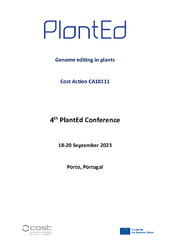| dc.creator | Yildirim, Kubilay | |
| dc.creator | Kucuk, Ilkay Sevgen | |
| dc.creator | Kavas, Musa | |
| dc.creator | Miladinović, Dragana | |
| dc.date.accessioned | 2023-09-29T11:40:05Z | |
| dc.date.available | 2023-09-29T11:40:05Z | |
| dc.date.issued | 2023 | |
| dc.identifier.uri | http://fiver.ifvcns.rs/handle/123456789/3757 | |
| dc.description.abstract | Sunflower is one of the most important oil crops in the world that become a strategic plant due to the increased demand for its oil in recent years. Sunflower has low climate demand that enables it to grow in many regions of Europe. The biggest problem in sunflower cultivation is the presence of parasitic plants called broomrape (O. cumana). The seeds of these non-photosynthetic parasitic plants germinate with the secretion of Sesquiterpene Lactones (STL) from the roots of the sunflower. After attachment to the roots of the sunflower, it absorbs the water and all the nutrients from the host. Just one broomrape plant can produce millions of tiny seeds that can survive more than 15 years in the soil and can contaminate many fields in a region. Classical herbicides and mechanical techniques are not effective on these parasitic plants, since it already causes great damage to the plant when it rises above the ground. Many sunflower lines resistant to broomrape have been developed in last decades. However, the resistance of these lines was broken by emergence of new virulent broomrape strains. In recent years, secretion of Sesquiterpene Lactones (STLs) from sunflower roots has been found to trigger the germination of broomrape seeds. The genes encoding the enzymes (HaGAS, HaGAO, HaG8H, HaCOS) functional in STL biosynthesis in sunflower have been well characterized in recent years. In the light of all these information, genes of the enzymes that catalyze the production STLS was aimed to knockout with CRISPR/Cas9 technique in the project. | sr |
| dc.language.iso | en | sr |
| dc.relation | COST Action CA18111: Genome editing in plants - a technology with transformative potential | sr |
| dc.rights | openAccess | sr |
| dc.rights.uri | https://creativecommons.org/licenses/by/4.0/ | |
| dc.source | Book of Abstracts, 4th PlantEd Conference, Porto, 18-20 September 2023 | sr |
| dc.subject | sunflower | sr |
| dc.subject | resistant lines | sr |
| dc.subject | broomrape | sr |
| dc.subject | CRISPR-CAS9 | sr |
| dc.title | Development of resistant sunflower lines to broomrape using CRISPR-CAS9 | sr |
| dc.type | conferenceObject | sr |
| dc.rights.license | BY | sr |
| dc.citation.epage | 53 | |
| dc.citation.spage | 53 | |
| dc.identifier.fulltext | http://fiver.ifvcns.rs/bitstream/id/9613/bitstream_9613.pdf | |
| dc.identifier.rcub | https://hdl.handle.net/21.15107/rcub_fiver_3757 | |
| dc.type.version | publishedVersion | sr |


